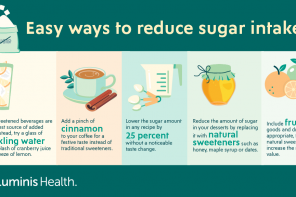Thanksgiving. It’s a day to relax. Watch football. And most of all, eat good food.
But if you’re one of the many people managing your diabetes or watching your weight, this holiday can be a challenge.
According to the Calorie Control Council, the average American eats 3,000 calories at Thanksgiving dinner. And that’s not including appetizers, drinks or snacks throughout the day.
Need help making healthy choices at the Thanksgiving dinner table? Here are six tips.
- Don’t skip meals.
You might think you’re doing your health a favor by “saving” calories for the big Thanksgiving dinner. But skipping meals throws off your blood sugar levels. If your Thanksgiving meal is at the usual dinner hour, eat a healthy breakfast and light lunch.
- Eat —don’t drink — your calories.
Say no to sugary drinks, like cocktails, holiday punches and fruit juices. They are full of empty calories that spike your blood sugar and can lead to weight gain. Go for calorie-free drinks — including water, unsweetened tea and seltzers.
- Slow down.
Did you know it takes time for your brain to register that you’re full? Savor each bite. Make a conscious effort to set your utensils down between bites. Keep dessert portions small. And eat slowly to enjoy the taste longer. If you’re not hungry, don’t eat.
- Put the food away.
Clear the table after the meal to reduce the temptation to snack. Often, after-dinner snacking is a social activity, rather than a way to satisfy hunger. Try gathering in the living room, away from the kitchen.
- Include healthy options.
Create a balanced meal – one that includes protein, carbohydrates, healthy fats and plenty of fruits and vegetables. If you’re a guest, offer to bring a seasonal salad or fruit tray for a healthy side.
- Get moving.
Get members of your household together and go for a walk. This will take the focus away from food. And the extra steps will help you burn calories and reduce your blood sugar levels. Or, if the weather isn’t cooperating, round up some indoor activities that don’t involve food. Like playing board games, telling stories or sharing photos.
- Group education classes and access to support groups
- Highly individualized counseling
- One-on-one nutrition counseling
- Instruction on insulin pump usage and continuous glucose monitoring




